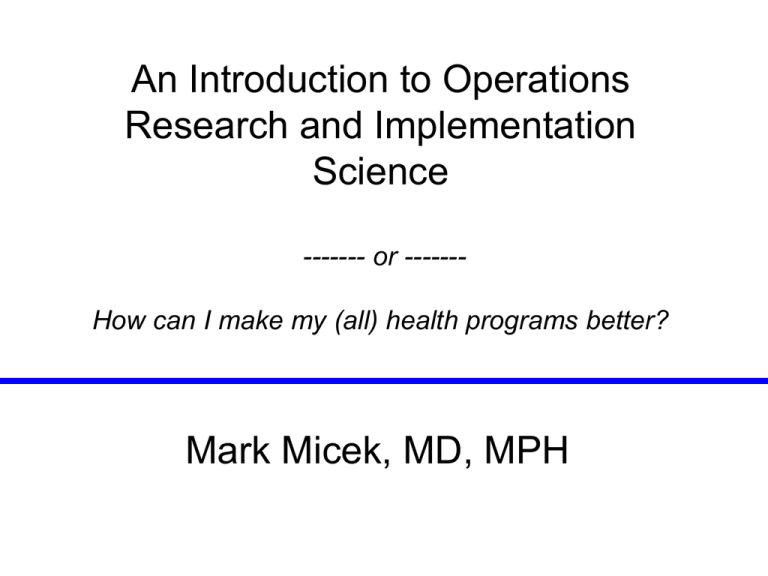Operations Research Mini Course
advertisement

An Introduction to Operations Research and Implementation Science ------- or ------How can I make my (all) health programs better? Mark Micek, MD, MPH Goals of this talk • Why do we need OR/IS? • What is OR/IS, and how is it different from other types of research? • How do you do OR/IS? Why do we need OR/IS? • What we know ≠ what we do Quality indicator Median (World) Median (Low income) Antenatal care coverage (>1 visit) 94% 71% Births by skilled health personnel 96% 40% Measles vaccination 92% 78% ARVs for advanced HIV infection 30% 34% Quality indicator (US) Source: WHO. World Health Statistics 2011. Median 2000-2001 B-blockers <24hrs in MI 69% Antibiotics <8hrs for pneumonia 87% Mammogram q2yrs 60% Lipid panel q2yrs in diabetics 60% Source: Jenks SF et al, Change in the quality of care delivered to Medicare beneficiaries, 1998-1999 to 2000-2001. JAMA. 2003;289:305-312. Why is it difficult to achieve targets of health care delivery? Why is it difficult to achieve targets of health care delivery? • Major constraint = weak health systems – Cannot provide adequate services given realities of target population • Human and capital resource limitations • Management and supervision • Poor process design – “Every process is perfectly designed to give you exactly the outcome you get.” – Don Berwick, IHI The question for OR/IS • Is it possible to improve the efficiency of health programs? Even within significant resource constraints? • If so, can research methodology help to do this? T0 Identify Problem, Need, Opportunity, Approaches Basic science T1 T2 T3 T4 Discovery, Foundation Research Access Efficacy Dissemination and Program Implementation Evaluate Health Impact in Real World Observational studies; Phase I/II Phase III, Metaanalyses OR/IS, Phase IV * Adapted from: Institute of Translational Health Sciences, www.iths.org/about/translational Population-based studies Defining features of OR/IS • Conceptualization – Focus of research • Health program (not epi or clinical causality) • Key = know program data, policies, processes (flow mapping) – Goal of research • OR: Help health program (not generalizable knowledge) • IS: Develop models to deliver proven interventions on a large scale (possibly generalizable knowledge) • Methodological – Study outcomes • Process, outputs, outcomes (less clinical impacts) – Study designs • Integrated into health program (not large separate study) • Facility-based, quasi-experimental designs more common Quasi-experimental designs: Non-random assignment & control group Non-equivalent Control Group Design Time Exp group O1 X O2 Non-RA Control group O3 O4 Time-Series Design Time Exp group O1 O2 O3 X O4 O5 O6 Stepped-Wedge Time-Series Design Time Non-RA Exp group 1 O1 X O2 Exp group 2 O5 O6 Exp group 3 O9 O10 X O3 O4 O7 O8 O11 X O12 Differences between OR and clinical studies • Clinical studies: primary goal = understand causality – Studies are rigid, controlled, lots of study resources going into adhering to strict study protocol • OR: primary goal = improve system – Rigid studies are less relevant in real world – Implementation of an intervention is subject to multiple influences that are difficult to control • These influences can become an OUTCOME of OR/IS: “What influences the implementation of my intervention?” Variation in implementation • Often responsible for differences in results • More rigid studies less relevant in real world • Should have plan to measure: – Fidelity: whether primary components of intervention were implemented – Sustainability: whether intervention continues over time – Causes of variations (sometimes difficult to measure) • Staff turn-over • Local champion • Degree of supervision • Presence of external funding Often times the most enlightening part of the study What influences implementation of an intervention? Source: Proctor EK et al, Implementation research in Mental Health Services: an emerging science with conceptual, methodological, and training challenges. Adm Policy Ment Health. 2009;36:24-34. Broad methodologies of OR • Modeling (classic) – Develop mathematical model to mimic health care system – Manipulate to find the best possible “solution” • Optimize efficiency • Maximize Y given constraints X • Intervention-based (Population Council) – Identify bottlenecks in service delivery – Design/test better ways to deliver services How to do OR: Find a problem, try to fix it Population Council Linear IHI Collaborative Cyclical 1. Identify program problem 1. Plan 2. Generate program solution 2. Do 3. Test program solution 3. Study 4. Use/disseminate results 4. Act Act Plan Study Do How to do OR: HAI/UW • Problem identification 1. Validate data 2. Identify variability in performance: Disaggregate 3. Map steps/identify bottlenecks in the system: compare high and low performers, other studies as necessary (quantitative, qualitative) • Intervention study 4. Make changes to address bottlenecks 5. Measure impact of changes 6. If it works, expand changes and inform policymakers Quiz: which ones are OR/IS? 1. Does male circumcision reduce risk of HIV transmission/ acquisition? 2. What is the rate of HIV resistance in the population that comes to my ART clinic? 3. Is a 3-months of INH + Rifapentine better than 9 months of INH for treatment of LTBI in Africa? 4. Can rapid CD4 tests improve the proportion of patients starting ART? 5. How can I reduce the time required to respond to disease outbreaks? 6. Can plumpy-nut reduce mortality among malnourished children in my health program? The End








